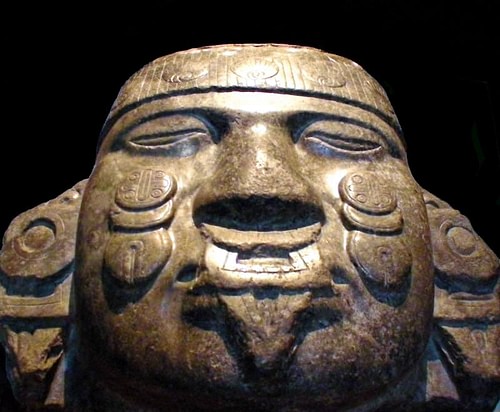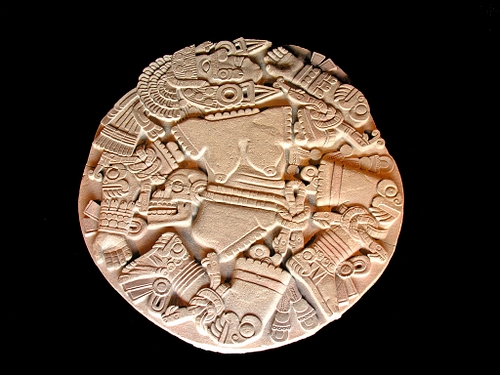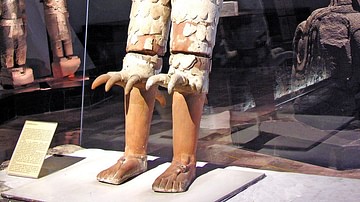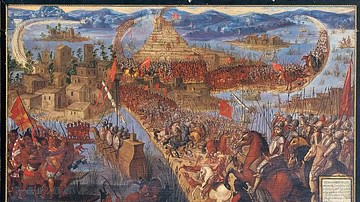
Coyolxauhqui (pron. Koy-ol-shauw-kee) was the Aztec goddess of the Moon or Milky Way who was famously butchered by her brother Huitzilopochtli, the god of war, in Aztec mythology. This story was commemorated in a celebrated large relief stone found at the foot of the pyramid of sacrifices, the Templo Mayor at the Aztec capital Tenochtitlan.
Coyolxauhqui vs. Huitzilopochtli
Coyolxauhqui, whose name signifies 'Painted with Bells', was considered either the sister or mother of Huitzilopochtli, the Aztec god of war and patron of Tenochtitlan. In the first version of this mythical duel, Coyolxauhqui upset her son Huitzilopochtli when she insisted on staying at the legendary sacred mountain Coatepec ('Snake Mountain', also spelt Coatepetl) and not following Huitzilopochtli's plan to re-settle at a new site – the eventual Tenochtitlan. The god of war got his own way by decapitating and eating the heart of Coyolxauhqui, after which he led the Aztecs to their new home.
In the second version of this family strife, rebellious Coyolxauhqui led her 400 brothers, known as the Centzon Huitznaua (the 'Four Hundred Huiztnaua' who represented the stars of the southern sky), in a bid to kill her mother, the goddess Coatlicue. The pretext for this attack had been the news that Coatlicue had become pregnant in somewhat bizarre and dishonourable circumstances. Performing her duties, one day, as a cleaner at the shrine on the top of the sacred mountain Coatepec, a ball of feathers suddenly descended from the heavens and when Coatlicue tucked this into her belt it miraculously impregnated her. The resulting child was none other than the powerful warrior Huitzilopochtli.
Coyolxauhqui's plot came unstuck, though, when one of the Huiztnaua lost heart and decided to warn the still unborn Huitzilopochtli. Rising to his mother's defence the god sprang from the womb fully-grown and fully-armed as an invincible warrior. In another version, the god springs from his mother's severed neck after Coyolxauhqui had decapitated her. Either way, with his formidable weapon, the xiuhcoatl ('Fire Serpent') which was actually a ray of the sun, the warrior-god swiftly butchered his unruly siblings and, chopping up Coyolxauhqui into several large chunks, he lobbed the pieces down the mountainside. The head of the goddess was tossed into the sky and so became the moon.
This gruesome sibling myth may symbolise the daily victory of the Sun (one of Huitzilpochtli's associations) over the Moon and stars. That is even if the association with the moon has no particular archaeological evidence to support it and some scholars have argued that Coyolxauhqui was, instead, associated with the Milky Way.
The Great Coyolxauhqui Stone
The myth of Coyolxauhqui's demise at the hands of Huitzilopochtli was commemorated in a large stone disk, known as the Great Coyolxauhqui Stone, which was excavated at the base of the Templo Mayor, Tenochtitlan. It depicts in high relief the dismembered and decapitated corpse of Coyolxauhqui and dates to c. 1473 CE during the reign of Axayacatl. The goddess wears only a warrior's belt with skull, a headdress with eagle down feathers, and a bell on her cheek. The Templo Mayor pyramid was actually a twin shrine to the rain god Tlaloc and the war god Huitzilopochtli. A double staircase climbed the temple, and the disk was placed, significantly, at the base of the steps leading to Huitzilpochtli's shrine. It was atop this temple that humans were sacrificed and their bodies dismembered and tossed down the steps to land at the base, just as in the myth on Snake Mountain.
Besides reminding of the importance of Huitzilopochtli, the stone was also a stark warning to the enemies of the Aztecs who saw themselves as the victorious warrior Huitzilopochtli. Defeated warriors led up the steps of the Temple Mayor for the ultimate sacrifice would have been reminded that they were soon to be the equivalent of the defeated Coyolxauhqui.
The 3.4 m (10.5 ft) diameter stone was re-discovered in 1978 CE when workers were excavating the basement of a bookstore in downtown Mexico City. In condensing a three-dimensional scene onto a two-dimensional plain, it is one of the great masterpieces of Aztec art and now resides in the Museo del Templo Mayor in the city in which it was discovered.
Other Representations in Art
Other notable representations of Coyolxauhqui are a fragmentary greenstone (diorite) slab which is older and (along with a stucco sculpture of the goddess) lay beneath the stone disk described previously. This earlier stone shows Huitzilopochtli's xiuhcoatl weapon piercing the goddess' chest and probably dates to the reign of Motecuhzoma I (1440-1469 CE).
Another famous representation of Coyolxauhqui is a large greenstone severed head found at Tenochtitlan which was probably carved during the reign of Ahuitzotl (1486-1502 CE). The goddess once again has the golden coyolli bells on each cheek. This head now resides in the Museum of Anthropology in Mexico City.






